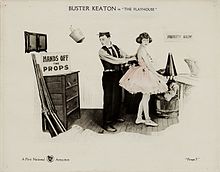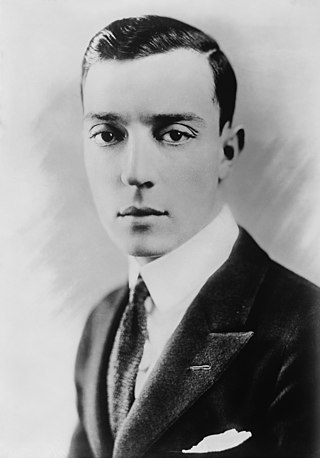
Joseph Frank "Buster" Keaton was an American actor, comedian and film director. He is best known for his silent films during the 1920s, in which he performed physical comedy and inventive stunts. He frequently maintained a stoic, deadpan facial expression that became his trademark and earned him the nickname "The Great Stone Face".

Sherlock Jr. is a 1924 American silent comedy film starring and directed by Buster Keaton and written by Clyde Bruckman, Jean Havez, and Joseph A. Mitchell. It features Kathryn McGuire, Joe Keaton, and Ward Crane.

Edward Francis Cline was an American screenwriter, actor, writer and director best known for his work with comedians W.C. Fields and Buster Keaton. He was born in Kenosha, Wisconsin and died in Hollywood, California.
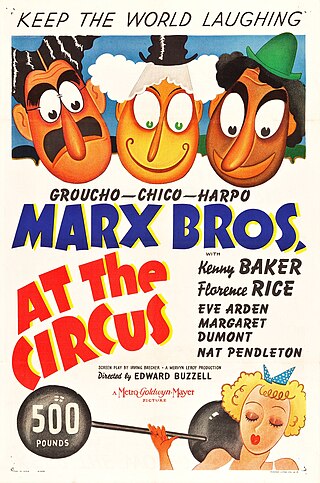
At the Circus is a 1939 comedy film starring the Marx Brothers released by Metro-Goldwyn-Mayer in which they help save a circus from bankruptcy. The film contains Groucho Marx's classic rendition of "Lydia the Tattooed Lady". The supporting cast includes Florence Rice, Kenny Baker, Margaret Dumont, and Eve Arden. The songs, including "Lydia the Tattooed Lady", "Two Blind Loves", and "Step Up and Take a Bow", were written by the team of Harold Arlen and Yip Harburg, who'd recently furnished the songs for another MGM film that same year, The Wizard of Oz.

One Week is a 1920 American two-reel silent comedy film starring Buster Keaton, the first independent film production he released on his own. The film was written and directed by Keaton and Edward F. Cline, and runs for 19 minutes. Sybil Seely co-stars. The film contains a large number of innovative visual gags largely pertaining to either the house or to ladders.

Clyde Adolf Bruckman was an American writer and director of comedy films during the late silent era as well as the early sound era of cinema. Bruckman collaborated with such comedians as Buster Keaton, Monty Banks, W. C. Fields, Laurel and Hardy, The Three Stooges, Abbott and Costello, and Harold Lloyd.

Convict 13 is a 1920 two-reel silent comedy film starring Buster Keaton. It was written and directed by Keaton and Edward F. Cline.
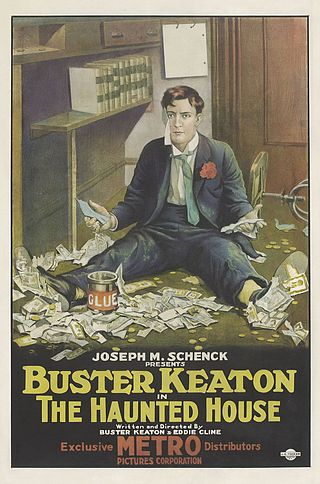
The Haunted House is a 1921 American two-reel silent comedy film starring Buster Keaton. It was written and directed by Keaton and Edward F. Cline. The film has a runtime of 21 minutes.
Seven Chances is a 1925 American silent comedy film directed by and starring Buster Keaton, based on the play of the same name by Roi Cooper Megrue, produced in 1916 by David Belasco. Additional cast members include T. Roy Barnes, Snitz Edwards, and Ruth Dwyer. Jean Arthur, a future star, has an uncredited supporting role. The film's opening scenes were shot in early Technicolor.

The High Sign is a 1921 two-reel silent comedy film starring Buster Keaton, and written and directed by Keaton and Edward F. Cline. Its runtime is 21 minutes. Although One Week (1920) was Keaton's first independent film short released, The High Sign was the first one made. Disappointed with the result, Keaton shelved it and the film was not released until the following year. The title refers to the secret hand signal used by the film's underworld gang.

The Scarecrow is a 1920 American two-reel silent comedy film starring Buster Keaton, and written and directed by Keaton and Edward F. Cline.

Hard Luck is a 1921 American two-reel silent comedy film starring Buster Keaton, written and directed by Keaton and Edward F. Cline. It runs 22 minutes. For sixty years it was Keaton's only major lost film until it was partially reconstructed in 1987, with the critical final scene—which Keaton called the greatest laugh-getting scene of his career—still missing. It was later discovered in a Russian archive print, and now the full film is available.

Back Stage is a 1919 American two-reel silent comedy film directed by and starring Roscoe "Fatty" Arbuckle and featuring Buster Keaton and Al St. John.
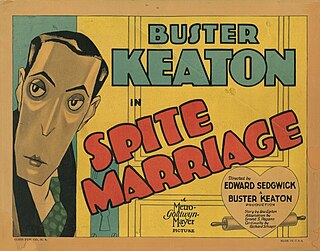
Spite Marriage is a 1929 American silent comedy film co-directed by Buster Keaton and Edward Sedgwick and starring Keaton and Dorothy Sebastian. It is the second film Keaton made for MGM and his last silent film, although he had wanted it to be a "talkie" or full sound film. While the production has no recorded dialogue, it does feature an accompanying synchronized score and recorded laughter, applause and other sound effects in some scenes. Keaton later wrote gags for some up-and-coming MGM stars like Red Skelton, and from this film recycled many gags, some shot-for-shot, for Skelton's 1943 film I Dood It.

The Saphead is a 1920 American comedy-drama film featuring Buster Keaton. It was the actor's first starring role in a full-length feature and the film that launched his career as a leading man. Keaton was cast on the recommendation of Douglas Fairbanks.

The Boat is a 1921 American two-reel silent comedy film written and directed by, and starring Buster Keaton. Contemporary reviews consider it one of his best shorts, with One Week (1920), The Playhouse (1921) and Cops (1922). It is presently in the public domain. The International Buster Keaton Society takes its name, The Damfinos, from the name of the film's boat.

The Frozen North is a 1922 American short comedy film directed by and starring Buster Keaton. The film is a parody of early western films, especially those of William S. Hart. The film was written by Keaton and Edward F. Cline. The film runs for around 17 minutes. Sybil Seely and Bonnie Hill co-star in the film.
Grand Slam Opera is a 1936 American short comedy film starring Buster Keaton and produced by Educational Pictures.

Speak Easily is a 1932 American pre-Code comedy film starring Buster Keaton, Jimmy Durante, and Thelma Todd, and directed by Edward Sedgwick. Keaton and Durante were again paired in The Passionate Plumber and What! No Beer? Keaton later used many of the physical gags he created for this film when he wrote (uncredited) gags for the Marx Brothers' A Night At The Opera.

Elgin Lessley was an American hand-crank cameraman of the silent film era—a period of filmmaking when virtually all special effects work had to be produced inside the camera during filming. Though Lessley worked earlier with Roscoe "Fatty" Arbuckle, and later with Harry Langdon, he is best known for the groundbreaking effects he produced with Buster Keaton, who dubbed him "the human metronome" for his ability to crank consistently at any requested speed.
